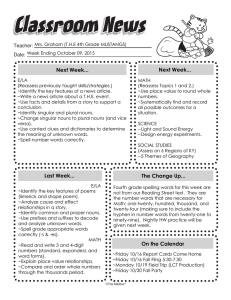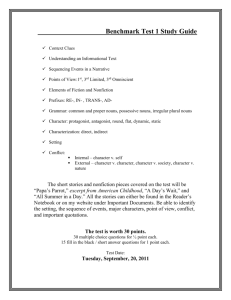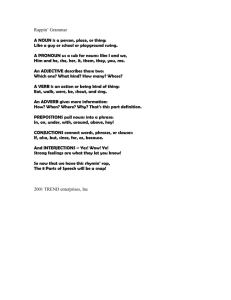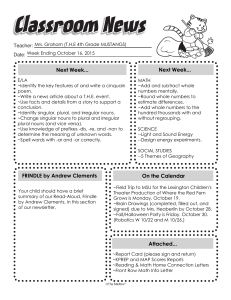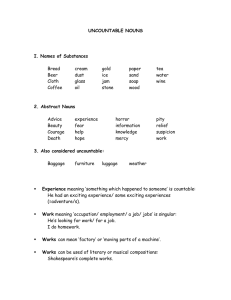The English Articles and Nouns
advertisement
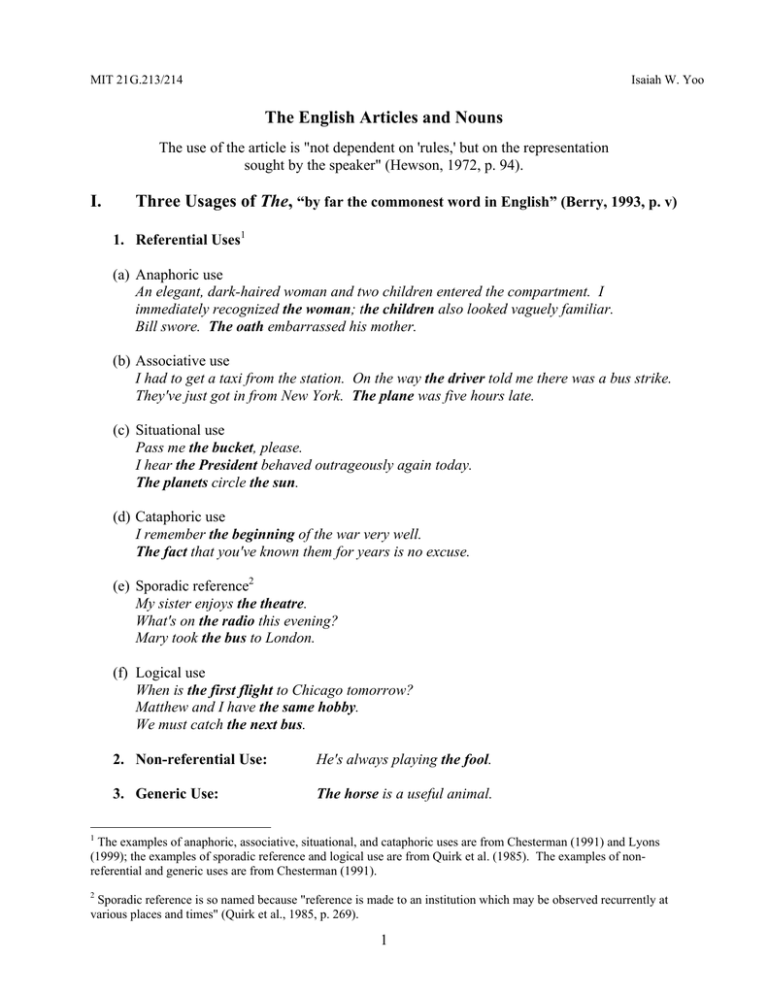
MIT 21*.213/214 Isaiah W. Yoo The English Articles and Nouns The use of the article is "not dependent on 'rules,' but on the representation sought by the speaker" (Hewson, 1972, p. 94). I. Three Usages of The, “by far the commonest word in English” (Berry, 1993, p. v) 1. Referential Uses1 (a) Anaphoric use An elegant, dark-haired woman and two children entered the compartment. I immediately recognized the woman; the children also looked vaguely familiar. Bill swore. The oath embarrassed his mother. (b) Associative use I had to get a taxi from the station. On the way the driver told me there was a bus strike. They've just got in from New York. The plane was five hours late. (c) Situational use Pass me the bucket, please. I hear the President behaved outrageously again today. The planets circle the sun. (d) Cataphoric use I remember the beginning of the war very well. The fact that you've known them for years is no excuse. (e) Sporadic reference2 My sister enjoys the theatre. What's on the radio this evening? Mary took the bus to London. (f) Logical use When is the first flight to Chicago tomorrow? Matthew and I have the same hobby. We must catch the next bus. 2. Non-referential Use: He's always playing the fool. 3. Generic Use: The horse is a useful animal. 1 The examples of anaphoric, associative, situational, and cataphoric uses are from Chesterman (1991) and Lyons (1999); the examples of sporadic reference and logical use are from Quirk et al. (1985). The examples of nonreferential and generic uses are from Chesterman (1991). 2 Sporadic reference is so named because "reference is made to an institution which may be observed recurrently at various places and times" (Quirk et al., 1985, p. 269). 1 II. Generic Reference • Use of Generic The to Indicate Membership (1, 2, 3, and 5 from Berry, 1993; 4 from Master, 1996) 1. The third task of the teacher is criticism. 2. The red squirrel is steadily dying out. 3. It won’t hurt the brain. 4. The computer is changing the business world. 5. The kitchen can be a very suitable place to take a nap. • Both the and a(n)can be used to express generic statements. The following examples are listed from most common to least common (Thewlis, 2000, p. 312). Examples Lions are mighty creatures. A lion is a mighty creature. The lion is a mighty creature. • Explanations ∅ with plural count or noncount nouns is the most common way to make generic statements. A/an with singular count nouns is less common, but also acceptable. The with singular count nouns is also possible, but sounds very formal to most native speakers. The definite plural can also be used generically with nouns of nationality and names of animals and plants representing groups larger than species (Lyons, 1999, p. 181). 1. The Swiss consume a lot of chocolate. 2. The cats – at least the big ones like tigers and pumas – are particularly fierce predators. Q: What is the most common error with the use of articles? 1. Incorrect addition of the, as in In his novel Caleb Williams, Godwin fights against *the unjust society (Klages-Kubitzki, 1995, p. 85). 2. "Most errors with articles made by learners of English involve the definite article" (Berry, 1993, p. 22). 2 III. Summary of the Use of Articles (adapted from Byrd & Benson, 1992) Articles Usage 1. with indefinite singular or plural count nouns ("Indefinite" means that the speaker thinks that the listener does not know what is being talked about.): e.g. I met a musician at the concert. 1. with definite singular or plural count nouns ("Definite" means that the The speaker thinks that the listener knows what is being talked about.): e.g. I bought the required textbook(s) for this class yesterday. 2. with definite noncount nouns: e.g. I found the information for my research project. 3. with generic singular count nouns: e.g. Modern life has been changed by the computer. 4. with some proper nouns that are plural or collective semantically: e.g. the United States; the Soviet Union Zero Article 1. with most proper nouns: e.g. John lives in Alaska. 2. with generic plural nouns: e.g. Tigers are both beautiful and dangerous. (∅) 3. with generic noncount nouns: e.g. People need water to live. Two 1. Singular-count nouns must have an article or another central important determiner (see Note). facts about 2. For generic meaning, noncount nouns never have an article or another articles central determiner. Note. Determiners are "used to specify the reference of a noun," and there are three subgroups among them: pre-, central-, and post-determiners (Biber et al., 1999, p. 258). Central determiners include articles, demonstratives (e.g. this, that), possessives (e.g. my, her, their), universal (each, every), dual (either, neither), WH (what, which, whose) determiners, assertive/non-assertive (some, any), and negative (no) (Master, 2002, pp. 339-340). A(n) IV. Situations in Which a Noun Is Considered Definite (in ESL textbooks) 1. Second or Subsequent Mention e.g. Long ago, an old woman lived in a village. The old woman had two grandchildren who came to the village to visit her every Sunday. 2. Shared Knowledge: e.g. Pass the salt; When's the party? 3. Postmodification/Nouns with Qualification e.g. the car that I hit in the parking lot; the president of our organization 4. Unique Items: e.g. the sun; the universe; the stars 5. Unique Adjectives e.g. They even use the same lawyers; He was the only doctor I knew. 6. Superlatives and Other Ranking Adjectives e.g. the slowest walker; the most difficult assignment 3 V. Countability of Nouns Conversion of noncount nouns into count nouns (Kaluza, 1981, p. 10) (a) "a unit of": e.g. Can I have two coffees ("cups of coffee")? (b) "a kind of": e.g. They drink three or four different wines at every meal. (c) "an instance of": e.g. He did her a kindness. Conversion of proper nouns into count nouns (Kaluza, 1981, pp. 24-25) (a) My mother was married to a Field. (b) Among the books I saw a Shakespeare. (c) At the circus, I saw a real Hercules. Conversion of count nouns into noncount nouns (Allan, 1980, p. 547)3 (a) The scrapyard is full of smashed car awaiting recycling. (b) There's not enough table for everyone to sit at. (c) Emmy finds squashed spider more nauseous than the thing alive. Potentially, every noun in English could be considered countable or uncountable; for various reasons, some nouns are more countable or uncountable than others (Close, 1981). Therefore, VI. Allan (1980) asserts that all nouns are basically uncountable, with many of them being countable to a certain extent, and that there are eight levels of countability, car being 100% countable and equipment being the true uncountable. So, What Do We Do? In many cases, choosing a or the is only a matter of viewpoint and style (Christophersen, 1939). "Shakespeare hesitated between mount and the mount used before a proper name" (Christophersen, 1939, p. 179). "Research is an uncountable noun for the vast majority of native speakers; however, it is not at all inconceivable that it may someday become countable—perhaps as a result of pressure from nonnative speakers" (Swales & Feak, 1994). 3 Count to noncount conversion also occurs when a count noun is interpreted in terms of quantity, after expression of amount, e.g. an inch of pencil and a few square feet of floor (Kaluza, 1981, p. 11). 4 MIT OpenCourseWare http://ocw.mit.edu 21G.213 / 21G.214 High-Intermediate Academic Communication Spring 2004 For information about citing these materials or our Terms of Use, visit: http://ocw.mit.edu/terms.


